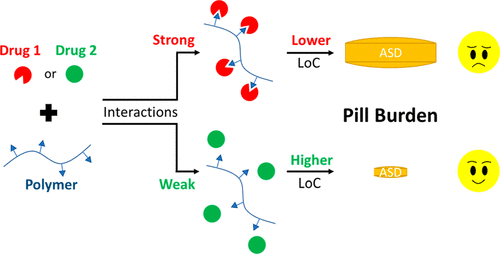当前位置:
X-MOL 学术
›
Mol. Pharmaceutics
›
论文详情
Our official English website, www.x-mol.net, welcomes your feedback! (Note: you will need to create a separate account there.)
Impact of Drug–Polymer Intermolecular Interactions on Dissolution Performance of Copovidone-Based Amorphous Solid Dispersions
Molecular Pharmaceutics ( IF 4.9 ) Pub Date : 2021-07-28 , DOI: 10.1021/acs.molpharmaceut.1c00419 Chailu Que 1 , Alexandru Deac 1 , Dmitry Y Zemlyanov 2 , QingQing Qi 3 , Anura S Indulkar 4 , Yi Gao 5 , Geoff G Z Zhang 4 , Lynne S Taylor 1
Molecular Pharmaceutics ( IF 4.9 ) Pub Date : 2021-07-28 , DOI: 10.1021/acs.molpharmaceut.1c00419 Chailu Que 1 , Alexandru Deac 1 , Dmitry Y Zemlyanov 2 , QingQing Qi 3 , Anura S Indulkar 4 , Yi Gao 5 , Geoff G Z Zhang 4 , Lynne S Taylor 1
Affiliation

|
For poorly soluble drugs formulated as amorphous solid dispersions (ASDs), fast and complete release with the generation of drug-rich colloidal particles is beneficial for optimizing drug absorption. However, this ideal dissolution profile can only be achieved when the drug releases at the same normalized rate as the polymer, also known as congruent release. This phenomenon only occurs when the drug loading (DL) is below a certain value. The maximal DL at which congruent release occurs is defined as the limit of congruency (LoC). The purpose of this study was to investigate the relationship between drug chemical structure and LoC for PVPVA-based ASDs. The compounds investigated shared a common scaffold substituted with different functional groups, capable of forming hydrogen bonds only, halogen bonds only, both hydrogen and halogen bonds, or nonspecific interactions only with the polymer. Intermolecular interactions were studied and confirmed by X-ray photoelectron spectroscopy and infrared spectroscopy. The release rates of ASDs with different DLs were investigated using surface area normalized dissolution. ASDs with hydrogen bond formation between the drug and polymer had lower LoCs, while compounds that were only able to form halogen bonds or nonspecific interactions with the polymer achieved considerably higher LoCs. This study highlights the impact of different types of drug–polymer interactions on ASD dissolution performance, providing insights into the role of drug and polymer chemical structures on the LoC and ASD performance in general.
中文翻译:

药物-聚合物分子间相互作用对共聚维酮基无定形固体分散体溶解性能的影响
对于配制为无定形固体分散体 (ASD) 的难溶性药物,快速和完全释放并产生富含药物的胶体颗粒有利于优化药物吸收。然而,只有当药物以与聚合物相同的标准化速率释放时,才能实现这种理想的溶出曲线,也称为一致释放。这种现象只发生在载药量(DL)低于某个值时。发生一致性释放的最大 DL 定义为一致性极限 (LoC)。本研究的目的是研究基于 PVVPA 的 ASD 的药物化学结构与 LoC 之间的关系。所研究的化合物共享一个被不同官能团取代的共同支架,能够仅形成氢键,仅形成卤素键,氢键和卤素键,或仅与聚合物的非特异性相互作用。通过 X 射线光电子能谱和红外光谱研究和证实了分子间相互作用。使用表面积归一化溶出度研究了具有不同 DLs 的 ASD 的释放速率。在药物和聚合物之间形成氢键的 ASD 具有较低的 LoC,而只能与聚合物形成卤素键或非特异性相互作用的化合物获得了更高的 LoC。本研究强调了不同类型的药物-聚合物相互作用对 ASD 溶出性能的影响,从而深入了解药物和聚合物化学结构对 LoC 和 ASD 性能的总体作用。通过 X 射线光电子能谱和红外光谱研究和证实了分子间相互作用。使用表面积归一化溶出度研究了具有不同 DLs 的 ASD 的释放速率。在药物和聚合物之间形成氢键的 ASD 具有较低的 LoC,而只能与聚合物形成卤素键或非特异性相互作用的化合物获得了更高的 LoC。本研究强调了不同类型的药物-聚合物相互作用对 ASD 溶出性能的影响,从而深入了解药物和聚合物化学结构对 LoC 和 ASD 性能的总体作用。通过 X 射线光电子能谱和红外光谱研究和证实了分子间相互作用。使用表面积归一化溶出度研究了具有不同 DLs 的 ASD 的释放速率。在药物和聚合物之间形成氢键的 ASD 具有较低的 LoC,而只能与聚合物形成卤素键或非特异性相互作用的化合物获得了更高的 LoC。本研究强调了不同类型的药物-聚合物相互作用对 ASD 溶出性能的影响,从而深入了解药物和聚合物化学结构对 LoC 和 ASD 性能的总体作用。在药物和聚合物之间形成氢键的 ASD 具有较低的 LoC,而只能与聚合物形成卤素键或非特异性相互作用的化合物获得了更高的 LoC。本研究强调了不同类型的药物-聚合物相互作用对 ASD 溶出性能的影响,从而深入了解药物和聚合物化学结构对 LoC 和 ASD 性能的总体作用。在药物和聚合物之间形成氢键的 ASD 具有较低的 LoC,而只能与聚合物形成卤素键或非特异性相互作用的化合物获得了更高的 LoC。本研究强调了不同类型的药物-聚合物相互作用对 ASD 溶出性能的影响,从而深入了解药物和聚合物化学结构对 LoC 和 ASD 性能的总体作用。
更新日期:2021-09-06
中文翻译:

药物-聚合物分子间相互作用对共聚维酮基无定形固体分散体溶解性能的影响
对于配制为无定形固体分散体 (ASD) 的难溶性药物,快速和完全释放并产生富含药物的胶体颗粒有利于优化药物吸收。然而,只有当药物以与聚合物相同的标准化速率释放时,才能实现这种理想的溶出曲线,也称为一致释放。这种现象只发生在载药量(DL)低于某个值时。发生一致性释放的最大 DL 定义为一致性极限 (LoC)。本研究的目的是研究基于 PVVPA 的 ASD 的药物化学结构与 LoC 之间的关系。所研究的化合物共享一个被不同官能团取代的共同支架,能够仅形成氢键,仅形成卤素键,氢键和卤素键,或仅与聚合物的非特异性相互作用。通过 X 射线光电子能谱和红外光谱研究和证实了分子间相互作用。使用表面积归一化溶出度研究了具有不同 DLs 的 ASD 的释放速率。在药物和聚合物之间形成氢键的 ASD 具有较低的 LoC,而只能与聚合物形成卤素键或非特异性相互作用的化合物获得了更高的 LoC。本研究强调了不同类型的药物-聚合物相互作用对 ASD 溶出性能的影响,从而深入了解药物和聚合物化学结构对 LoC 和 ASD 性能的总体作用。通过 X 射线光电子能谱和红外光谱研究和证实了分子间相互作用。使用表面积归一化溶出度研究了具有不同 DLs 的 ASD 的释放速率。在药物和聚合物之间形成氢键的 ASD 具有较低的 LoC,而只能与聚合物形成卤素键或非特异性相互作用的化合物获得了更高的 LoC。本研究强调了不同类型的药物-聚合物相互作用对 ASD 溶出性能的影响,从而深入了解药物和聚合物化学结构对 LoC 和 ASD 性能的总体作用。通过 X 射线光电子能谱和红外光谱研究和证实了分子间相互作用。使用表面积归一化溶出度研究了具有不同 DLs 的 ASD 的释放速率。在药物和聚合物之间形成氢键的 ASD 具有较低的 LoC,而只能与聚合物形成卤素键或非特异性相互作用的化合物获得了更高的 LoC。本研究强调了不同类型的药物-聚合物相互作用对 ASD 溶出性能的影响,从而深入了解药物和聚合物化学结构对 LoC 和 ASD 性能的总体作用。在药物和聚合物之间形成氢键的 ASD 具有较低的 LoC,而只能与聚合物形成卤素键或非特异性相互作用的化合物获得了更高的 LoC。本研究强调了不同类型的药物-聚合物相互作用对 ASD 溶出性能的影响,从而深入了解药物和聚合物化学结构对 LoC 和 ASD 性能的总体作用。在药物和聚合物之间形成氢键的 ASD 具有较低的 LoC,而只能与聚合物形成卤素键或非特异性相互作用的化合物获得了更高的 LoC。本研究强调了不同类型的药物-聚合物相互作用对 ASD 溶出性能的影响,从而深入了解药物和聚合物化学结构对 LoC 和 ASD 性能的总体作用。



























 京公网安备 11010802027423号
京公网安备 11010802027423号